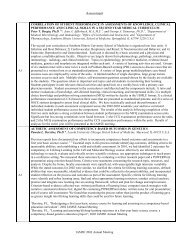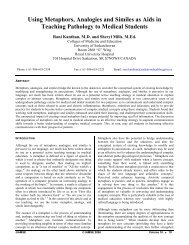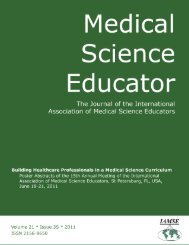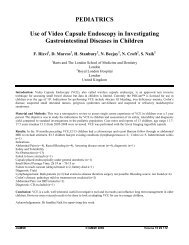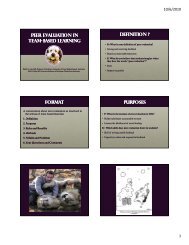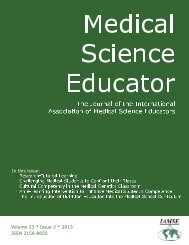Click here to view complete journal in pdf-format - IAMSE
Click here to view complete journal in pdf-format - IAMSE
Click here to view complete journal in pdf-format - IAMSE
You also want an ePaper? Increase the reach of your titles
YUMPU automatically turns print PDFs into web optimized ePapers that Google loves.
and on the year-end exam. At the very least, the<br />
students’ perceptions that weekly quizzes are<br />
beneficial <strong>to</strong> their success are sufficient <strong>to</strong> warrant<br />
their cont<strong>in</strong>ued <strong>in</strong>clusion <strong>in</strong> our curriculum.<br />
Assessment Abstract ID: 122 Award Nom<strong>in</strong>ee<br />
FIRST-YEAR MEDICAL STUDENT<br />
ATTITUDES ON NUTRITION TOPICS<br />
BEFORE AND AFTER A NUTRITION<br />
COURSE<br />
Oren Rosenthal, James Leiber, and Mark Best,<br />
LECOM-Braden<strong>to</strong>n College of Osteopathic<br />
Medic<strong>in</strong>e, Braden<strong>to</strong>n, FL USA<br />
PURPOSE<br />
The objective of this study was <strong>to</strong> evaluate students’<br />
chang<strong>in</strong>g attitudes on the follow<strong>in</strong>g: importance of<br />
<strong>in</strong>clud<strong>in</strong>g nutrition <strong>in</strong> their medical curriculum,<br />
<strong>in</strong>fluence of a nutrition course on their eat<strong>in</strong>g<br />
habits, beliefs about how they will spend time<br />
counsel<strong>in</strong>g future patients, and ability <strong>to</strong> provide<br />
<strong>in</strong><strong>format</strong>ion <strong>to</strong> patients on the relationship of<br />
nutrition <strong>to</strong> major chronic diseases.<br />
METHODS<br />
Onl<strong>in</strong>e surveys were sent <strong>to</strong> 154 first-year<br />
osteopathic medical students, pre and post a<br />
medical nutrition course. A 1-5 rat<strong>in</strong>g scale was used<br />
for each survey statement. Data was compared by<br />
the Mann-Whitney rank sum test.<br />
RESULTS<br />
Response rates were 98% pre-course and 79% postcourse.<br />
Nutrition-related survey items, all at<br />
P≤0.001 post-course compared <strong>to</strong> pre-course,<br />
<strong>in</strong>cluded: <strong>in</strong>terest, education importance,<br />
prescription use, and health of patients and self.<br />
Comparison of Pre <strong>to</strong> Post course responses on the<br />
item about ability <strong>to</strong> supply patients valid<br />
<strong>in</strong><strong>format</strong>ion on the relationship of nutrition <strong>to</strong> the<br />
follow<strong>in</strong>g conditions was: for cancer (P≤0.001);<br />
metabolic syndrome (P=0.005), coronary artery<br />
disease (P=0.009), hypertension (P=0.003), and<br />
ag<strong>in</strong>g (P≤0.001).<br />
CONCLUSIONS<br />
Students value the <strong>in</strong>clusion of nutrition <strong>to</strong>pics <strong>in</strong><br />
their medical education. More students conclude<br />
that hav<strong>in</strong>g taken a nutrition course, they will be<br />
able <strong>to</strong> offer valid <strong>in</strong><strong>format</strong>ion <strong>to</strong> patients about the<br />
relationship of nutrition <strong>to</strong> cancer, metabolic<br />
syndrome, coronary artery disease, hypertension,<br />
and changes associated with ag<strong>in</strong>g than they did<br />
prior <strong>to</strong> the course, and they predict they will spend<br />
more time counsel<strong>in</strong>g patients on nutrition.<br />
Students’ attitudes on nutrition are <strong>in</strong>fluenced by<br />
tak<strong>in</strong>g a course <strong>in</strong> the first year of medical school,<br />
and they believe this will transfer <strong>to</strong> behaviors <strong>in</strong><br />
practice.<br />
Assessment Abstract ID: 123 eDemo<br />
ASSESSING RESIDENT'S<br />
UNDERSTANDING OF ACGME CORE<br />
COMPETENCIES THROUGH CREATIVE<br />
EXPRESSION<br />
Lorra<strong>in</strong>e Fugazzi, Timothy Sullivan, MD, Brahim<br />
Ardolic MD, Staten Island University Hospital,<br />
USA<br />
PURPOSE<br />
Residents are regularly evaluated as <strong>to</strong> their<br />
understand<strong>in</strong>g of the six ACGME Core<br />
Competencies. The evaluation typically relies on<br />
standard, multiple-choice written exam<strong>in</strong>ations on<br />
course content, as well as discussion and re<strong>view</strong><br />
with their Program Direc<strong>to</strong>r and other key cl<strong>in</strong>ical<br />
faculty. Achievement of satisfac<strong>to</strong>ry performance <strong>in</strong><br />
all six core competencies is necessary for successful<br />
completion of the program. The study objective is <strong>to</strong><br />
explore whether describ<strong>in</strong>g and evaluat<strong>in</strong>g<br />
residents’ creative responses <strong>to</strong> the six Core<br />
Competencies augments the educa<strong>to</strong>rs’ assessment<br />
of the learn<strong>in</strong>g process, and also whether it<br />
enhances the residents’ educational experience.<br />
METHODS<br />
After participat<strong>in</strong>g <strong>in</strong> presentations on the Core<br />
Competencies, 58 residents were given a template<br />
with six blank spaces bear<strong>in</strong>g head<strong>in</strong>gs reflect<strong>in</strong>g<br />
each of the six Core Competencies. They were<br />
simply asked <strong>to</strong> draw their responses <strong>to</strong> each of the<br />
Competencies <strong>in</strong> whatever way they chose. They<br />
could illustrate the concept of the Competency, or<br />
their reaction <strong>to</strong> it, as they wished.<br />
RESULTS<br />
In the first phase of this study the <strong>in</strong>vestiga<strong>to</strong>rs will<br />
subject the draw<strong>in</strong>gs <strong>to</strong> a systematic analysis, <strong>to</strong><br />
determ<strong>in</strong>e thematic content, emotional content, and<br />
literal content with respect <strong>to</strong> how accurately the<br />
draw<strong>in</strong>gs reflect their <strong>in</strong>tended object (i.e. one of the<br />
Core Competencies). It is hypothesized that the<br />
<strong>in</strong>tense stimulus represented by the “Core<br />
Competencies,” will yield <strong>in</strong>sights <strong>in</strong><strong>to</strong> their<br />
imag<strong>in</strong>ative responses <strong>to</strong> key stressors occurr<strong>in</strong>g<br />
dur<strong>in</strong>g their professional development. Draw<strong>in</strong>gs<br />
will be evaluated, with guidel<strong>in</strong>es established by the<br />
<strong>in</strong>vestiga<strong>to</strong>rs <strong>in</strong> consultation with a psychologist<br />
experienced <strong>in</strong> the <strong>in</strong>terpretation of psychological<br />
tests, by bl<strong>in</strong>ded raters.<br />
Medical Science Educa<strong>to</strong>r © <strong>IAMSE</strong> 2012 Volume 22(4S) 283



